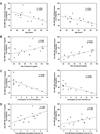Effects of atorvastatin on cerebral blood flow in middle-aged adults at risk for Alzheimer's disease: a pilot study
- PMID: 22175654
- PMCID: PMC3576818
- DOI: 10.2174/156720512803251075
Effects of atorvastatin on cerebral blood flow in middle-aged adults at risk for Alzheimer's disease: a pilot study
Abstract
Background/aims: Hypercholesterolemia in midlife increases risk for Alzheimer's disease (AD) and contributes to cerebrovascular dysregulation - an early finding in preclinical AD pathology. Statins improve vascular reactivity, but it is unknown if they increase regional cerebral blood flow (CBF) in individuals at risk for AD.
Methods: In a randomized, controlled, double-blind pilot study, 16 asymptomatic middle-aged adults with parental history of AD were randomized to atorvastatin or placebo daily for 4 months. At baseline and month 4, regional CBF was measured using arterial spin-labeling magnetic resonance imaging and endothelial function was measured using brachial artery ultrasound.
Results: At baseline, participants with low HDL-cholesterol, higher global vascular risk, and greater endothelial dysfunction had reduced regional CBF in areas of the brain related to memory and learning (all p < 0.03). Using voxel-based analysis, 4 months of atorvastatin increased CBF in bilateral hippocampi, fusiform gyrus, putamen and insular cortices compared to placebo.
Conclusion: In this pilot study, atorvastatin increased regional CBF in persons at risk for AD. Further research is warranted to confirm whether statins increase CBF in areas of the brain related to memory and learning and whether such perfusion changes are associated with a delay in the onset of AD.
Clinical trial registration: http://clinicaltrials.gov Identifier: NCT00751907.
Conflict of interest statement
Figures


Similar articles
-
Effects of pitavastatin versus atorvastatin on the peripheral endothelial progenitor cells and vascular endothelial growth factor in high-risk patients: a pilot prospective, double-blind, randomized study.Cardiovasc Diabetol. 2014 Jul 16;13:111. doi: 10.1186/s12933-014-0111-1. Cardiovasc Diabetol. 2014. PMID: 25027585 Free PMC article. Clinical Trial.
-
Randomized controlled trial of atorvastatin in mild to moderate Alzheimer disease: LEADe.Neurology. 2010 Mar 23;74(12):956-64. doi: 10.1212/WNL.0b013e3181d6476a. Epub 2010 Mar 3. Neurology. 2010. PMID: 20200346 Clinical Trial.
-
Placebo-controlled trial of high-dose atorvastatin in patients with severe cerebral small vessel disease.Stroke. 2009 May;40(5):1721-8. doi: 10.1161/STROKEAHA.108.540088. Epub 2009 Mar 12. Stroke. 2009. PMID: 19286582 Clinical Trial.
-
Circulating cholesterol levels, apolipoprotein E genotype and dementia severity influence the benefit of atorvastatin treatment in Alzheimer's disease: results of the Alzheimer's Disease Cholesterol-Lowering Treatment (ADCLT) trial.Acta Neurol Scand Suppl. 2006;185:3-7. doi: 10.1111/j.1600-0404.2006.00690.x. Acta Neurol Scand Suppl. 2006. PMID: 16866904 Clinical Trial.
-
Causes and consequences of baseline cerebral blood flow reductions in Alzheimer's disease.J Cereb Blood Flow Metab. 2021 Jul;41(7):1501-1516. doi: 10.1177/0271678X20982383. Epub 2021 Jan 14. J Cereb Blood Flow Metab. 2021. PMID: 33444096 Free PMC article. Review.
Cited by
-
Effects of Plasma Lipids and Statins on Cognitive Function.Chin Med J (Engl). 2018 Feb 20;131(4):471-476. doi: 10.4103/0366-6999.225062. Chin Med J (Engl). 2018. PMID: 29451153 Free PMC article. Review.
-
Statins, cognition, and dementia—systematic review and methodological commentary.Nat Rev Neurol. 2015 Apr;11(4):220-9. doi: 10.1038/nrneurol.2015.35. Epub 2015 Mar 24. Nat Rev Neurol. 2015. PMID: 25799928 Free PMC article.
-
Low cerebral blood flow is associated with lower memory function in metabolic syndrome.Obesity (Silver Spring). 2013 Jul;21(7):1313-20. doi: 10.1002/oby.20170. Epub 2013 May 19. Obesity (Silver Spring). 2013. PMID: 23687103 Free PMC article.
-
Mechanisms of interventions targeting modifiable factors for dementia risk reduction.Mol Neurodegener. 2025 Jun 23;20(1):75. doi: 10.1186/s13024-025-00845-w. Mol Neurodegener. 2025. PMID: 40551205 Free PMC article. Review.
-
Physical activity, cognitive function, and brain health: what is the role of exercise training in the prevention of dementia?Brain Sci. 2012 Nov 29;2(4):684-708. doi: 10.3390/brainsci2040684. Brain Sci. 2012. PMID: 24961266 Free PMC article.
References
-
- Breitner JC. Clinical genetics and genetic counseling in Alzheimer disease. Ann Intern Med. 1991 Oct 15;115(8):601–606. - PubMed
-
- Kivipelto M, Helkala EL, Laakso MP, Hanninen T, Hallikainen M, Alhainen K, et al. Apolipoprotein E epsilon4 allele, elevated midlife total cholesterol level, and high midlife systolic blood pressure are independent risk factors for late-life Alzheimer disease. Ann Intern Med. 2002 Aug 6;137(3):149–155. - PubMed
-
- Sparks DL, Scheff SW, Hunsaker JC, 3rd, Liu H, Landers T, Gross DR. Induction of Alzheimer-like beta-amyloid immunoreactivity in the brains of rabbits with dietary cholesterol. Exp Neurol. 1994 Mar;126(1):88–94. - PubMed
-
- Refolo LM, Malester B, LaFrancois J, Bryant-Thomas T, Wang R, Tint GS, et al. Hypercholesterolemia accelerates the Alzheimer's amyloid pathology in a transgenic mouse model. Neurobiol Dis. 2000 Aug;7(4):321–331. - PubMed
-
- Kitayama J, Faraci FM, Lentz SR, Heistad DD. Cerebral vascular dysfunction during hypercholesterolemia. Stroke. 2007 Jul;38(7):2136–2141. - PubMed

